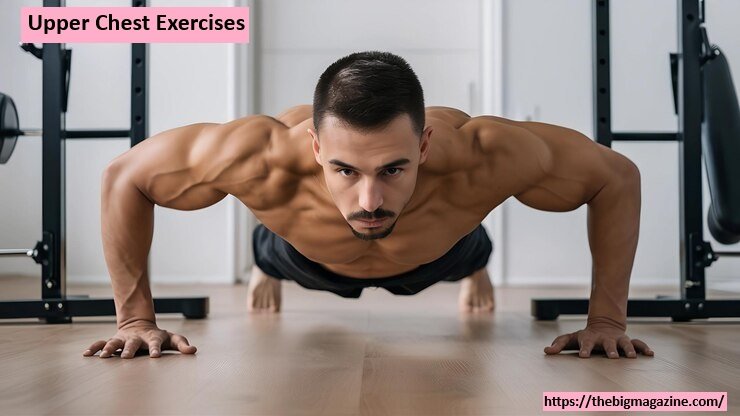Building a well-defined chest is a goal for many fitness enthusiasts, but it’s not just about working on your overall chest muscles. Focusing on the upper chest is crucial for achieving that balanced, powerful look. The upper chest, or the clavicular head of the pectoralis major, plays a significant role in the overall appearance and strength of your chest. In this article, we’ll explore some of the most effective upper chest exercises, how to perform them, and tips to maximize your results.
Understanding the Upper Chest Exercises
Before diving into specific exercises, it’s important to understand the anatomy of the Upper Chest. The pectoralis major is a large, fan-shaped muscle that covers much of the chest. It has two main parts: the clavicular head (upper chest) and the sternal head (middle and lower chest). The clavicular head originates from the clavicle (collarbone) and inserts into the humerus (upper arm bone).
The upper chest is often underdeveloped compared to the lower chest, as many traditional chest exercises, like the flat bench press, primarily target the sternal head. To achieve a more balanced chest, incorporating exercises that specifically engage the upper chest is essential.
Why Focus on the Upper Chest?
A well-developed upper chest adds fullness to the upper body, creating a more aesthetic and proportionate look. Additionally, strengthening the upper chest can improve overall chest strength, enhance shoulder stability, and prevent muscle imbalances that could lead to injury.
Benefits of Upper Chest Exercises:
- Improved Aesthetics: A fuller upper chest contributes to a more balanced and symmetrical appearance.
- Enhanced Strength: Targeting the upper chest increases overall chest strength, which can improve performance in other lifts.
- Shoulder Stability: A strong upper chest helps stabilize the shoulders during pressing movements, reducing the risk of injury.
- Injury Prevention: Strengthening the upper chest can prevent muscle imbalances, which are a common cause of shoulder and upper body injuries.
Best Upper Chest Exercises
To effectively target the upper chest, it’s important to include a variety of exercises that emphasize different angles and movements. Here are some of the best upper chest exercises that should be a part of your workout routine.
1. Incline Barbell Bench Press
The incline barbell bench press is one of the most effective exercises for targeting the upper chest. By adjusting the bench to a 30-45-degree angle, you shift the focus from the lower and middle chest to the upper chest.
How to Perform:
- Set an incline bench to a 30-45 degree angle.
- Lie on the bench with your feet flat on the floor.
- Grip the barbell slightly wider than shoulder-width.
- Lower the barbell to your upper chest, keeping your elbows at a 45-degree angle.
- Press the barbell back up to the starting position, fully extending your arms.
Tips:
- Keep your back flat against the bench to avoid lower back strain.
- Avoid flaring your elbows out too wide, as this can place unnecessary stress on the shoulders.
2. Incline Dumbbell Press
Similar to the incline barbell bench press, the incline dumbbell press targets the upper chest while allowing for a greater range of motion. Using dumbbells also engages the stabilizer muscles, promoting balanced strength development.
How to Perform:
- Set an incline bench to a 30-45 degree angle.
- Hold a dumbbell in each hand and lie back on the bench.
- Press the dumbbells above your chest with your palms facing forward.
- Lower the dumbbells to the sides of your chest, keeping your elbows slightly bent.
- Press the dumbbell back up to the starting position.
Tips:
- Focus on a slow and controlled movement to maximize muscle engagement.
- Avoid locking your elbows at the top of the movement to maintain tension on the chest muscles.
3. Incline Dumbbell Flyes
Incline dumbbell flies are an isolation exercise that specifically targets the upper chest. This movement emphasizes the stretch and contraction of the upper chest muscles, helping to build muscle definition.
How to Perform:
- Set an incline bench to a 30-45 degree angle.
- Hold a dumbbell in each hand and lie back on the bench.
- With a slight bend in your elbows, lower the dumbbells out to the sides in a wide arc.
- Bring the dumbbells back together above your chest, focusing on squeezing the chest muscles.
Tips:
- Keep the movement slow and controlled to avoid using momentum.
- Don’t lower the dumbbells too far to avoid straining the shoulder joints.
4. Reverse-Grip Bench Press
The reverse-grip bench press is an effective yet often overlooked exercise for targeting the upper chest. By reversing your grip on the barbell, you shift more of the workload onto the upper chest and biceps.
How to Perform:
- Set up a flat bench with a barbell.
- Grip the barbell with an underhand (supinated) grip, hands slightly wider than shoulder-width.
- Lower the barbell to your upper chest while keeping your elbows close to your body.
- Press the barbell back up to the starting position.
Tips:
- Start with a lighter weight to get used to the reverse grip.
- Ensure your wrists are stable throughout the movement to avoid strain.
5. Incline Push-Ups
Incline push-ups are a bodyweight exercise that targets the upper chest. This exercise is great for beginners or as a finisher in your upper chest workout.
How to Perform:
- Place your hands on a bench or elevated surface, slightly wider than shoulder-width apart.
- Keep your body straight from head to heels.
- Lower your chest towards the bench, bending your elbows.
- Push yourself back up to the starting position.
Tips:
- Keep your core engaged to maintain proper body alignment.
- To increase the difficulty, place your feet on a higher surface.
6. Cable Crossovers (Low Pulley)
Cable crossovers from a low pulley position are another excellent way to target the upper chest. This exercise focuses on the contraction and stretch of the chest muscles.
How to Perform:
- Set the pulleys on a cable machine to the lowest position.
- Stand between the pulleys and hold the handles with your palms facing up.
- Step forward slightly to create tension in the cables.
- Bring your hands together in front of your chest, crossing them slightly.
- Slowly return to the starting position.
Tips:
- Focus on squeezing your chest muscles at the peak of the movement.
- Keep the movement slow and controlled to maximize muscle engagement.
7. Landmine Press
The landmine press is a unique exercise that can effectively target the upper chest. This exercise involves pressing a barbell anchored at one end, allowing for a natural pressing motion that emphasizes the upper chest.
How to Perform:
- Place one end of a barbell into a landmine attachment or corner.
- Hold the other end of the barbell with both hands at chest height.
- Press the barbell upwards at a slight angle, fully extending your arms.
- Lower the barbell back to the starting position.
Tips:
- Keep your core engaged throughout the movement to maintain stability.
- Perform the exercise with one arm at a time to increase the focus on the upper chest.
8. Pec Deck Machine (High Position)
The pec deck machine can also be adjusted to target the upper chest by positioning the seat lower, so the handles align with your upper chest. This machine exercise is ideal for isolating the upper chest muscles.
How to Perform:
- Adjust the seat of the pec deck machine so that the handles are at upper chest level.
- Sit with your back against the pad and grip the handles.
- Bring the handles together in front of your chest, squeezing your upper chest muscles.
- Slowly return to the starting position.
Tips:
- Adjust the seat height to ensure proper alignment with your upper chest.
- Focus on a controlled movement to avoid using momentum.
Incorporating Upper Chest Exercises into Your Routine

To maximize the benefits of these upper chest exercises, it’s important to incorporate them into your workout routine effectively. Here are some tips on how to do so:
1. Frequency
Aim to train your chest, including the upper chest, 1-2 times per week. This allows for adequate recovery while providing enough stimulus for muscle growth. You can either dedicate an entire workout to your chest or include upper chest exercises as part of a full-body or upper-body routine.
2. Volume and Intensity
Perform 3-4 sets of each exercise, with 8-12 repetitions per set. This rep range is ideal for hypertrophy (muscle growth). Ensure that the weight you choose challenges you but still allows you to maintain proper form throughout each set.
3. Progressive Overload
To continue making progress, gradually increase the weight or resistance you use in these exercises over time. Progressive overload is key to building muscle and strength.
4. Variety
Incorporate a mix of compound and isolation Upper Chest Exercises to target the upper chest from different angles. Changing up your routine every few weeks can prevent plateaus and keep your workouts engaging.
5. Form and Technique
Focus on maintaining proper form and technique in each exercise. This not only helps prevent injury but also ensures that you are effectively targeting the upper chest muscles.
Conclusion
Building a strong, well-defined upper chest requires a combination of the right Upper Chest Exercises, proper form, and consistent effort. By incorporating the Upper Chest Exercises outlined in this guide into your workout routine, you can achieve a more balanced and aesthetically pleasing chest. Remember to focus on progressive overload, maintain good form, and allow adequate recovery time to see the best results.
Also, Read More: How to Bulk Up Fast.
